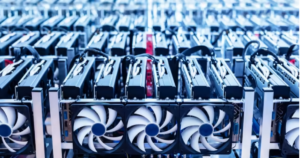The time it takes to mine 1 Bitcoin varies significantly based on several factors, with computing power being one of the most crucial. As the cryptocurrency space continues to evolve, so do the requirements for mining Bitcoin. In this article, we’ll break down the key considerations for anyone interested in mining Bitcoin and address some frequently asked questions about the process.
1. What is the time required to mine a single Bitcoin?
Determining the time it takes to mine 1 Bitcoin is not simple and mainly depends on the computing power each miner possesses. To better understand this process, let’s take a look at how miners earn rewards from Bitcoin mining.
Most Bitcoin miners today participate in mining pools to ensure stable rewards. There are many Bitcoin mining pools operating, but Foundry USA, AntPool, and F2Pool are the most prominent ones, holding the largest market shares.
A specific example can help clarify this issue. On November 14, 2024, data showed the percentage of Bitcoin blocks mined by each pool within the past 24 hours. While the data collection time is not critical in this example, it demonstrates that mining pools with higher hashrates have a greater chance of mining Bitcoin blocks.
Specifically, over the past 7 days, Foundry USA mined a total of 306 Bitcoin blocks. With an average hashrate of 228 EH/s (exahashes per second), Foundry USA mined an average of 45.1 Bitcoin blocks per day, which is equivalent to a daily reward of 141 BTC. To mine 1 BTC in one average day, a miner would need to contribute about 0.7% of the pool’s hashrate, or approximately 1.6 EH/s (or 1.6 million TH/s).

So, if you want to achieve this hashrate, you would need an extremely large number of mining machines. An Antminer S21 Pro ASIC miner, which costs around $4,000 and has a hashrate of 234 TH/s, would require 6,837 machines, with a total cost of approximately $27.3 million (excluding electricity, storage, and operational costs). This figure shows that mining 1 Bitcoin in a day requires a massive investment in both equipment and mining infrastructure.
2. The duration required to mine 1 Bitcoin is determined by the computing power you have
Mining 1 Bitcoin in a short time requires enormous computing power and a significant investment. In reality, not everyone can afford the infrastructure needed to mine Bitcoin on a large scale. So, how long does it take to mine 1 Bitcoin if you only invest in basic mining equipment? Let’s analyze this.
The calculations below are based on the Bitcoin mining difficulty as of November 14, 2024, and assume that the participant will purchase a Bitmain S21 Pro miner, which costs around $4,000 and has a hashrate of 234 TH/s. Note that costs such as electricity and equipment maintenance are not included in this calculation.
|
Number of mining rigs |
Hashrate |
Investment |
Time to mine 1 Bitcoin |
|
5 |
1,170 TH/s |
$20,000 |
1,367 days |
|
10 |
2,340 TH/s |
$40,000 |
683 days |
|
20 |
4,680 TH/s |
$80,000 |
341 days |
|
50 |
11,700TH/s |
$200,000 |
136 days |
|
100 |
23,400 TH/s |
$400,000 |
68 days |
|
500 |
117,000 TH/s |
$2,000,000 |
13 days |
|
1,000 |
234,000 TH/s |
$4,000,000 |
6 days |
|
5,000 |
1,170,000 TH/s |
$20,000,000 |
1.2 days |
|
6,837 |
1,600,000 TH/s |
$27,300,000 |
1 days |
It’s clear that the Bitcoin mining space is becoming increasingly competitive, and to mine 1 BTC in a relatively short period, you will need to invest heavily in mining equipment. In fact, with the Bitmain S21 Pro, you would have to make a substantial financial commitment to achieve good performance.
In the future, Bitcoin mining will only become more difficult. This is not only due to the increased total hashrate of the Bitcoin network over the past 5 years but also because of the halving event—a key feature of Bitcoin—that reduced the block reward from 6.25 BTC to 3.125 BTC. The combination of these factors makes Bitcoin mining a complex challenge, requiring both strategy and strong investment.
3. To mine 1 Bitcoin, you require high-performance, specialized hardware
Bitcoin mining is not a task that can be performed with regular equipment, and without specialized hardware, mining 1 Bitcoin in a reasonable timeframe is almost impossible. For example, using a gaming GPU to mine Bitcoin has become unfeasible due to the intense competition in the cryptocurrency mining market today.
Mining Bitcoin with a single machine nowadays is more like playing the lottery than a reliable source of income, unless you own a large-scale mining operation with thousands of machines. To make a profit from Bitcoin mining, the most effective option is to join a mining pool. However, even in a pool, you still need to make a significant investment in hardware to see real returns.
What makes solo Bitcoin mining unfeasible for most people is the reward distribution mechanism of the Bitcoin network. According to Bitcoin’s protocol, rewards are only given to miners who successfully mine a block. This means that if you only own 0.0001% of the network’s computing power (hashrate), you only have a 0.0001% chance of receiving a reward when a block is mined.

On the other hand, by joining a mining pool, you receive small Bitcoin rewards (proportional to the hashrate you contribute) whenever a member of the pool successfully mines a block. This increases your chances of receiving a reward, even though the amount of Bitcoin you receive each time is small. However, the rewards are more stable and consistent compared to solo mining.
4. You won’t be able to mine 1 Bitcoin unless you invest heavily in mining hardware
Bitcoin mining is a highly competitive field that requires significant investment if you want to achieve real value. Specifically, to mine 1 Bitcoin in one year, you would need approximately $25,200 for mining hardware, not including additional costs such as electricity. Today, Bitcoin mining is primarily controlled by large-scale mining farms operated by BTC mining companies, many of which are publicly traded.
Therefore, unless you are truly committed to mining, we do not recommend getting involved in this activity, as you are likely to face losses and contribute only a small fraction to the network’s security. If your goal is to support the decentralization of the Bitcoin network, a more reasonable option could be to operate a Bitcoin node without the need to mine.
If you believe in Bitcoin’s potential, purchasing Bitcoin might be a better option than risking investment in mining operations. If you’re unsure whether Bitcoin is an attractive investment right now, feel free to check out our articles to learn more about the investment potential of this cryptocurrency.
Mining Bitcoin today is far more complex than before, with the time to mine 1 Bitcoin largely depending on your equipment and resources. You’ll need powerful hardware, specialized equipment, and a solid understanding of the process. Consider the significant investment in hardware and electricity before starting, as mining Bitcoin without such an investment is unlikely to be profitable.















